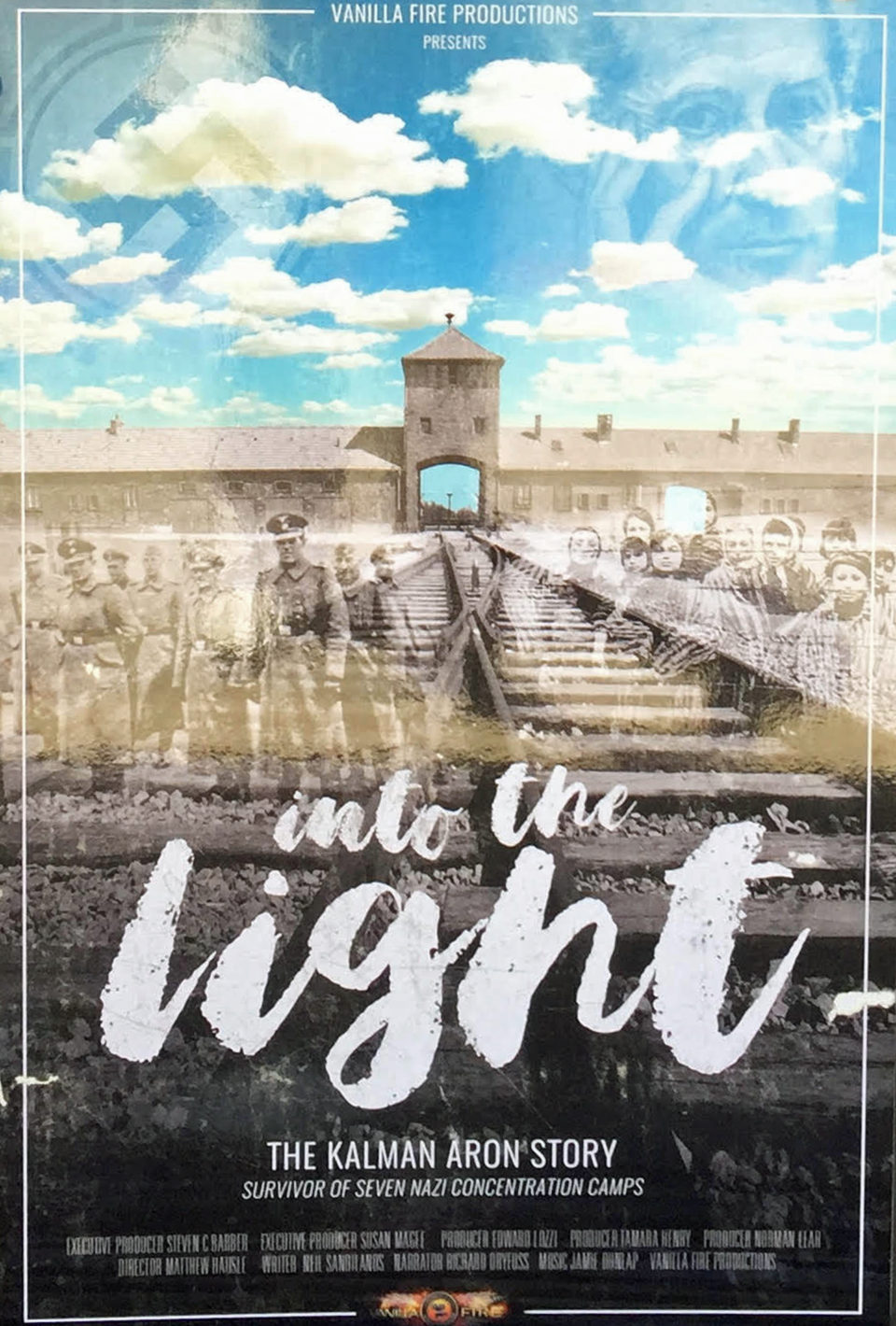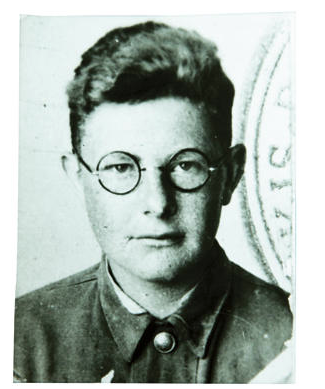Uncategorized Archives - INTO THE LIGHT
Kalman Aron, New York Times Obituary, March
On , | No Comments | In Uncategorized | By
Kalman Aron began drawing pencil and crayon portraits of his family in Latvia when he was 3. A child prodigy, he mounted his first one-boy gallery show when he was 7. He was commissioned to paint the official portrait of the Latvian prime minister when he was 13. He enrolled at an academy of fine arts in Riga, the capital, at 15.
Then, in 1941, when he was 16, the Germans invaded, and his parents, who were Jewish, were murdered. But Kalman’s artistic talent would spare his life. Over the next four years, he would survive seven Nazi concentration camps by swapping sketches of his captors and their families for scraps of food.
And he lived to become a prominent American portraitist. He died at 93 on Feb. 24 in Santa Monica, Calif., the Los Angeles Museum of the Holocaust said.
Mr. Aron was born near Riga on Sept. 24, 1924. His mother, Sonia, was from Lithuania; his father, Chaim, a custom women’s shoe designer, was from Russia.
Holocaust Survivor’s Art Kept Him Alive
On , | No Comments | In Blog, Holocaust, Uncategorized | By
In honor of International Holocaust Remembrance Day, I share Saul Gonzalez’s recent interview with Kalman Aron on Public Radio International’s broadcast, The World. Saul visits Kalman at his L.A. studio and learns how art has kept him alive, not just during the Holocaust, but throughout his lifetime.
“When you step inside artist Kalman Aron’s modest apartment in Beverly Hills, a lifetime of creation surrounds you. The walls are covered in paintings and finished canvases are stacked on the floors, a dozen deep. The paintings range from portraits to landscapes to abstract works. They’re just a fraction of the roughly 2,000 pieces Aron says he’s created over the decades.”
Click on the image below to listen to the full broadcast:
Film underway about Kalman Aron
On , | No Comments | In Blog, Uncategorized | By
I have exciting news! A documentary film about Kalman Aron is going to be made based on my book, INTO THE LIGHT: The Healing Art of Kalman Aron. You may have seen the recent article in the Jewish Journal about Kalman’s life: “Saved by Art: How One Man’s Skill Got Him Through Seven Nazi Camps and the Difficult Years that Followed.” (see video)
I am partnering with Steven C. Barber of Vanilla Fire Productions (see details below), and I ask for your help and ideas to raise $500,000 to shoot, write, edit, grade and score a 70-minute feature documentary. Think about friends, family foundations and organizations that might fund it.
Richard Dreyfuss has been approached to narrate. Norman Lear, renowned American TV writer and producer is on board as a producer. Edward Lozzi, verteran Hollywood public relations executive and former White House Press staffer, and one time publicist to Kalman Aron, is also on board as a producer.
Please consider making a pledge. This is an opportunity to bring Kalman’s inspirational story of overcoming evil and reclaiming his light to a much wider audience. I look forward to hearing from you by email or call me at 202 285-2200.
About the filmmaker:
Filmmaker Steven C. Barber is CEO of www.vanillafire.com, founded in 2006. Mr. Barber has enlisted the talents of Josh Brolin, Kelsey Grammer, Ed Harris, Dan Aykroyd and John Savage to narrate six feature documentaries. Three of these films made it to the Oscar short list.
Vanilla Fire Productions has been featured on CNN, ABC, CBS, FOX, BBC and in the New York Times and countless media outlets around the globe.
Vanilla Fire’s new film, “Into the Light,” is the company’s boldest and most far-reaching film to date. The story revolves around a 93-year-old Holocaust survivor named Kalman Aron. Mr. Aron survived seven Nazi camps by using his God-given talent as an artist. He would continuously draw the Nazi guards and commandants to get an extra piece of bread. This will be Vanilla Fire’s fourth run at Oscar in the feature film category along with best song and best original score.
Kalman Aron, survivor of Nazi camps, featured in Jewish Journal
On , | No Comments | In Blog, Holocaust, The Artist, Uncategorized, Videos | By
Kalman Aron’s story continues to be heard. Eitan Arom of the Jewish Journal writes about Aron’s remarkable past and the comfort he finds currently in art to soothe the loneliness he is experiencing at the age of 92:
“Apart from his wife and a part-time caretaker, it’s his paintings that keep him company.
‘I don’t have anybody to talk with,’ he said. ‘All my friends are gone. I had probably 15 friends. They were much older than me. I was the youngest one. And then suddenly, nobody here. I have drawings of them. A lot of drawings in the back there. Filled that room downstairs, filled up completely.’
At the age of 92, Kalman Aron is very much alive. The article quotes him as saying:
“’Friends of mine, they get old and they don’t know what to do, and they die of boredom,’ he said in his dining room, his eyes widening with intensity. ‘Boredom! And I’ll never die of boredom, as long as I have a piece of paper.'”
Kalman continues to be as dynamic as the light and color in his paintings. To read the full article, click here.
Interview: Dr. Margers Vestermanis, Holocaust Survivor, and Author Susan Beilby Magee
On , | One Comment | In Holocaust, Riga, Riga Holocaust, Uncategorized | By
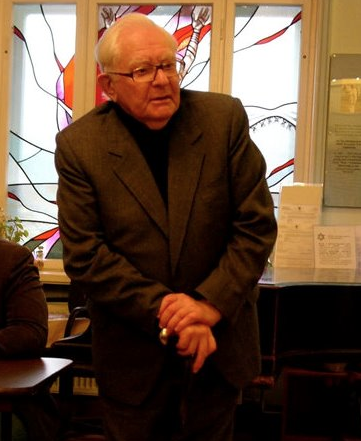
Dr. Margers Vestermanis, founder of the Museum and Documentation Center “Jews in Latvia.” (photo: Wikipedia)
In honor of International Holocaust Remembrance Day, I share a recent interview with Dr. Margers Vestermanis, Holocaust survivor, historian and expert on the history of Jews in Latvia. Born in Riga in 1925, he endured the horrors of the Holocaust. He escaped from the death march from the Dundaga concentration camp to the sea in the summer of 1944 and joined a group of partisans in the forests of Northern Courland until the war ended. After the war, he studied history in Riga, earned his PhD, and became an archivist in the State Historical Archives. He was dismissed in 1963 for writing a paper about the Holocaust, and he then worked as a high school teacher for many years. In 1990, following the Independence of Latvia, Dr. Vestermanis founded the Museum “Jews in Latvia” and served as its first director for many years.
I first met Dr. Vestermanis in Riga in 2004 when I was researching Kalman Aron’s life for my book—INTO THE LIGHT: The Healing Art of Kalman Aron. He kindly agreed to an interview in his office at the Jewish Community Center in Riga. Ten years later, I returned to Riga to present Kalman Aron’s story at an international conference at the same Jewish Community Center. Dr. Vestermanis agreed to a second interview to reflect on his experience and what he learned about human nature.
His responses to my questions are powerful, profound and insightful. I thank Dr. Margers Vestermanis for letting me share them with the world.
During the Holocaust, about 70,000 Latvian Jews lost their lives. Dr. Vestermanis has devoted his life to preserve the memory of Jewish life and culture in Latvia. He remains a vibrant voice, reminding us to “never forget.” I honor him and welcome your responses which I will share with him.
______________________________
Magee: What words can you use to describe the evil you experienced and how it affected your heart and soul?
Vestermanis: It was the first time that we felt outcast; we felt that our pain and the torture of death hardly disturbed anyone. It did not matter neither to our local society, nor to the rest of the world. This injury we, as individuals that survived the Holocaust and as the Jewish society as a whole, will harbor in our souls until the end of the days.
Magee: What is your understanding or view of human nature in general?
Vestermanis: A human is an egoist by nature. Love to our family and relatives, as well as friendship, should be brought up by our family members, teachers at school, and, in the end, by the society and the state. Of course, even the inveterate egoist feels the necessity of doing something good, positive, but usually this spontaneous glimpse is extinguished by arguments and ice-cold calculation.
Magee: What have you learned about your own nature?
Vestermanis: It is said, that a human comes from his or her childhood, from ancestral home. I come from a family focused on German culture that would decline even thoughts of possible assimilating. In contrast, there was cultivated the feeling of Jewish national pride for our input into civilization and culture. Since I was six years old, a private Rabbi taught me the Holy Scripture and other ancient Jewish books that were perceived in my family not as religious tenets, but mythological basics of our national culture. This sense of significance of our people, high national self-consciousness was, with no doubt, the most important and decisive aspect that helped me to survive the Holocaust.
Magee: How did you survive? What resources within yourself did you use to survive?
Vestermanis: Surviving the Holocaust was a mere accident. I was young, physically strong, and, what is the most important, I saved the will to resist. After several unsuccessful attempts to escape, an accident helped me: the concentration camp Dundaga, where also Kalman Aaron was held, due to the approach of the Red army in the end of July in 1944 was moved in a strong pace of “death march” to ports in Liepaja and Ventspils. Many people died on the way, but when our path ran through the forested place under Ugale, many people made the last effort to jump over the ditches on the sides of the road and rushed to the forest. I was one of them. I managed do join the antifascist partisan troop of Latvian people, who did not want to join the SS legion. In our troop, there were also soviet prisoners who escaped from German camp and even one German deserter (defector) Obergefreiter “Luftwaffe” (driver of anti-airforce artillery) Egon Klinke, who became my friend later.
The western side of Latvia later transformed into “Courland pocket”, where the Red army locked about 300 000 German soldiers – 16th and 18th Wehrmacht armies that could not escape from the “pocket” up to 9 may 1945. During this time the armies hurled all effort into going through forests searching for those who escaped, and on the 26th of December our troop was destroyed. My German friend Egon and I were among the few people that managed to break through, but after 5 days – on the New Year night of 1945 I lost my friend too, and until 9 may 1945 I was wondering around the forest as an “armed partisan loner”. I would like to highlight that without help from a friendly part of Latvian people I could not survive in the forest during the time of “Courland pocket”. Professor of the University of Jerusalem Dov Levin, historiographer of the resistance of Baltic Jews, writes: “Marger Vestermann was the last Jewish partisan of the World War II, who met the day of German capitulation going out of the forest with weapon in his hands.” This is only partly true – one more armed partisan was the other former prisoner of Dundaga concentration camp Jakov Rossein, who has already passed.
Magee: How did the Holocaust inform the choices you have made in your life since and how have you found meaning, given the experience?
Vestermanis: I would like to answer your fifth question with the words of the great “hunter of Nazi war criminals” Simon Wiesenthal. He writes: “When I will die and fall into another world, the millions of souls of killed Jews will surround me and ask: “What did you do with your life, that you managed to save?” I could answer in many different ways, but I will tell them the most important thing: I did not forget you! (ich habe euch niche vergessen)!” Of course, it would be a sacrilege to compare myself with the famous Wiesenthal. However, his words were “credo” of all my “post-Holocaust life”: I devoted myself to preserving the memory of the world of Latvian Jews that died in horror, tears and seas of blood. This duty, this mission will not leave me until my last breath. And I am happy that it so happened.
Magee: How are Riga and Latvia different today? How are they the same?
Vestermanis: Latvia and Riga had never known brutal anti-Semitism; however, it existed, and still exists, in a latent form. Our major difference is that currently the recognition of our suffering is not enough, we demand the principal condemnation of those who are guilty, “our” murderers, a part of which as “displaced persons” escaped the responsibility on the West. The other part of them was arrested and condemned by the Soviet authorities of KGB, not always objective. Their families also suffered, they were deported to Siberia. Guilty or not – all of them are considered victims of the “red terror” and national martyr, to which are dedicated monuments, museums and so on. They use their special status. This inability and unwillingness to deal with the dark spots of national history are “neurological sensitive points” in our, in fact, good relationships.
Magee: What wisdom/what message do you wish to give the world and particularly to the children…to your grandchildren’s generation?
Vestermanis: To the children, grandchildren, and great grandchildren – to learn to live together, in peace. Peace is the main thing that our ancestors were dreaming of, and what we, the generation that went through all the flames of hell, bequeath to the entire world and to America as well.
Magee: What message do you want me to take home to Kalman Aron in America?
Vestermanis: I wish him – take it easy, my friend! Search for the last, the most important theme. For me it is still Holocaust.
My cousin, who subsequently survived in concentration camp Buchenwald, Boris Lurne, and who later in the States became one of the “apostles” of a new art movement called “No-art” shortly before his death sent me a large poster – on the black background with a yellow paint was pictured something strange, scary and unimaginable, like a nightmare. This work he dedicated to our common, eternal theme – Holocaust. In my opinion, it is the most exact attempt to deliver graphically to the consciousness of people something that can be called “unimaginable”. Good luck, my friend!
© 2015 Susan Beilby Magee
VIDEO: Susan Beilby Magee presents INTO THE LIGHT in Riga, Latvia, 11.24.14
On , | No Comments | In Riga, Uncategorized | By
Susan Beilby Magee presents INTO THE LIGHT: The Healing Art of Kalman Aron
at the 9th International Conference
JEWS IN A CHANGING WORLD
Riga, Latvia
Monday, November 24, 2014
Reflections on Trip to Riga
On , | No Comments | In Uncategorized | By
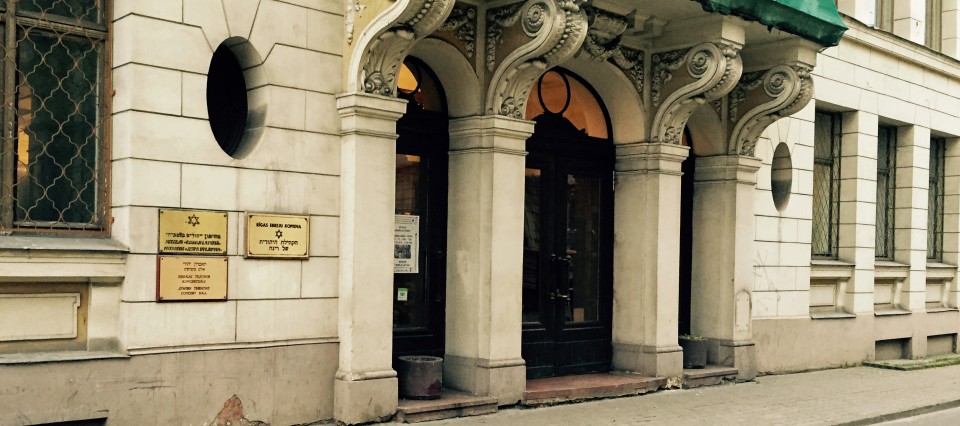
Jewish Community Center, Riga, Latvia
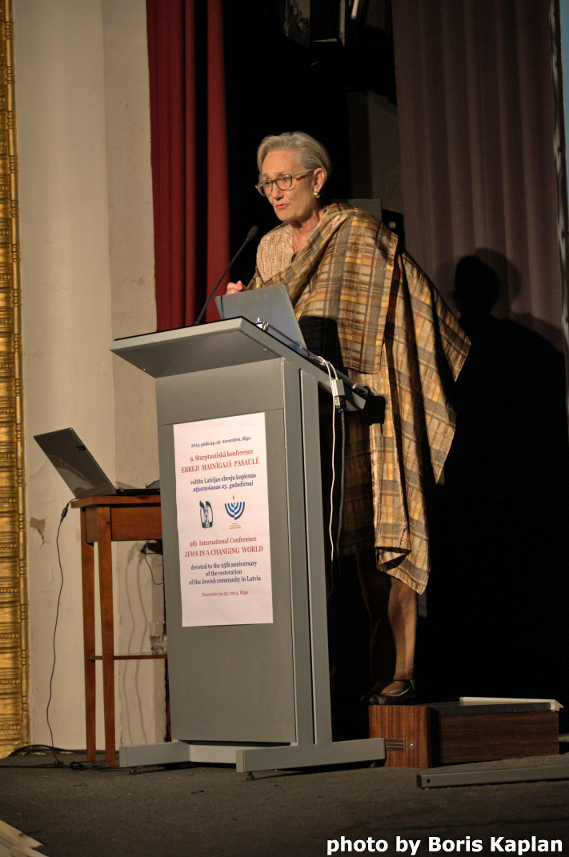
Susan Beilby Magee
Having returned from Riga, Latvia, three weeks ago, I have had time to reflect on my experience there and formulate questions I invite you to answer.
Let me first say that visiting Riga this second time was more difficult. I understand at a deeper level the impact of the killing and brutality that occurred there.
I was honored to present Kalman Aron’s story—INTO THE LIGHT The Healing Art of Kalman Aron–in the place where he was born. It feels like I have come full circle since my last visit 10 years ago when I was in Riga to research Kalman’s life.

Elena Spungina, Guide and Author, Gita Umanovska, Executive Director of The Council of the Jewish Communities of Latvia and Susan Beilby Magee.
I am deeply grateful to Gita Umanovska, Executive Director of The Council of the Jewish Communities of Latvia and the organizer of the International Conference “Jews In A Changing World” and to the US Department of State for hosting me. I am grateful to survivor and historian, Dr. Marger Vestermanis, for answering my interview questions. I also thank my dear friend and guide in 2004, Elena Spungina, my interpreter during this trip, Viktorija Andzane and filmmaker, Nikolajs Krasnopevcevs. I thoroughly enjoyed meeting and listening to the other excellent conference speakers–professors and researchers from Latvia, Germany and Canada.
Everyone at the Conference understood and celebrated Kalman Aron’s survival and success in creating a new life in America, devoted to his muse–making art. His journey deeply touched members of the audience.
Several things struck me during the trip:
- The Jewish people in Latvia are resilient, forming a community of about 12,000 people today. In 1935 there were about 93,000 Jews living in Latvia. Among the survivors is the extraordinary man, Marger Vestermanis, an historian and founder of the “Jews in Latvia” Museum. I will devote another blog to my conversation with him about his life and reaction to his experience in the Holocaust.
- Individuals continue to educate and honor the memory of their ancestors. Professor Leo Dribins discussed the history of the Russian deportation of 40,000 Jews from the Courland Province to Inner Russia and the Ukraine in 1915 during World War I. Then, I believe his grandparents’ were among the deportees.
- Historically, Jewish communities in this land have not been trusted in time of war. I learned that during the Napoleonic War the Russians moved Jewish families deeper into Russia for fear they would aid the French. I have already mentioned that the Russians deported 40,000 Jews from the Courland Province during World War I for fear they would aid the Germans. In 1941 just before retreating back into Russia as Germans entered Latvia, Stalin ordered 1,200 to 1,300 Latvian Jews to Siberia. So the long history of distrust and persecution of Jews continued during the 19th and 20th centuries in the land known today as Latvia. In spite of a difficult history, Jewish families live in Latvia and contribute richly to its national life.
I don’t believe in coincidences. I see meaning in everyone’s life journey. So given this history of persecution, I ask the following questions and invite you to share your answers:
*What are the gifts of being Jewish in today’s world?
*What are the challenges?
*What personal treasures result from overcoming these challenges?
*What is the Jewish legacy to the world?
Please share your answers and participate in a conversation about the meaning of being Jewish in the 21st century.
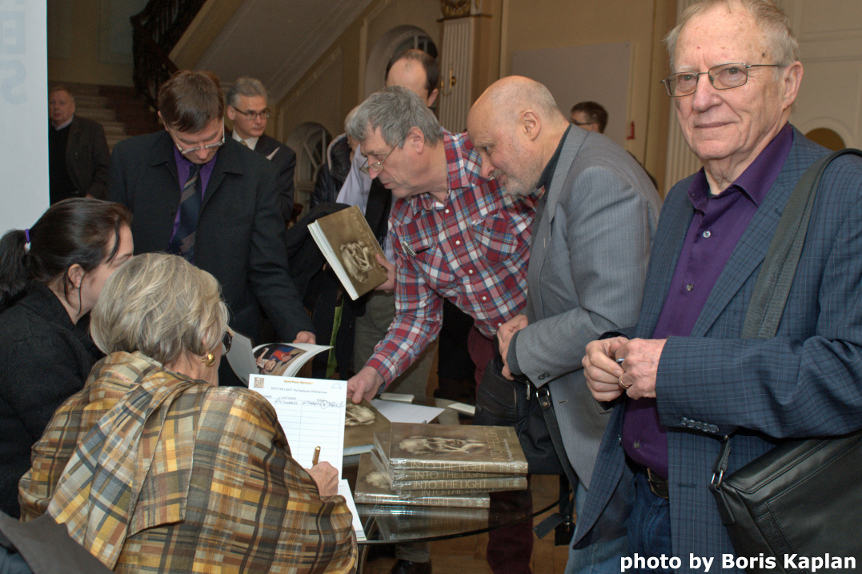
Susan Beilby Magee signs INTO THE LIGHT; Henry Blumberg (right), past-President of JewishGen Latvia-SIG
I conclude by inviting each of us to turn inward to heal our anger, hatred and fear so that we may live in peace with ourselves and each other. I believe that peace occurs one person at a time. We will see an end to genocide, brutality and killing around the world.
Note that in 2015 we will produce a video documenting the seminal places in Kalman Aron’s life in Riga. My hope is that this video will further supplement the rich documentation on the life of Kalman Aron.
© copyright Susan Beilby Magee, 2014


